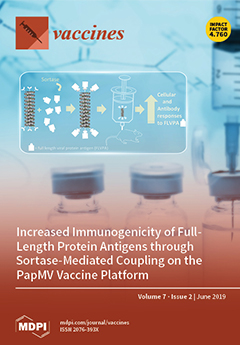Open AccessArticle
Bacterial Outer Membrane Vesicles (OMVs)-Based Dual Vaccine for Influenza A H1N1 Virus and MERS-CoV
by
Mahmoud M. Shehata, Ahmed Mostafa, Lisa Teubner, Sara H. Mahmoud, Ahmed Kandeil, Rabeh Elshesheny, Thamer A. Boubak, Renate Frantz, Luigi La Pietra, Stephan Pleschka, Ahmed Osman, Ghazi Kayali, Trinad Chakraborty, Mohamed A. Ali and Mobarak Abu Mraheil
Cited by 38 | Viewed by 6723
Abstract
Vaccination is the most functional medical intervention to prophylactically control severe diseases caused by human-to-human or animal-to-human transmissible viral pathogens. Annually, seasonal influenza epidemics attack human populations leading to 290–650 thousand deaths/year worldwide. Recently, a novel Middle East Respiratory Syndrome Coronavirus emerged. Together,
[...] Read more.
Vaccination is the most functional medical intervention to prophylactically control severe diseases caused by human-to-human or animal-to-human transmissible viral pathogens. Annually, seasonal influenza epidemics attack human populations leading to 290–650 thousand deaths/year worldwide. Recently, a novel Middle East Respiratory Syndrome Coronavirus emerged. Together, those two viruses present a significant public health burden in areas where they circulate. Herein, we generated a bacterial outer membrane vesicles (OMVs)-based vaccine presenting the antigenic stable chimeric fusion protein of the H1-type haemagglutinin (HA) of the pandemic influenza A virus (H1N1) strain from 2009 (H1N1pdm09) and the receptor binding domain (RBD) of the Middle East Respiratory Syndrome Coronavirus (MERS-CoV) (OMVs-H1/RBD). Our results showed that the chimeric antigen could induce specific neutralizing antibodies against both strains leading to protection of immunized mice against H1N1pdm09 and efficient neutralization of MERS-CoV. This study demonstrate that OMVs-based vaccines presenting viral antigens provide a safe and reliable approach to protect against two different viral infections.
Full article
►▼
Show Figures






